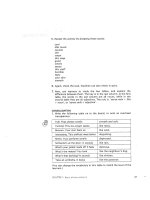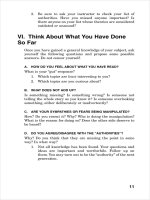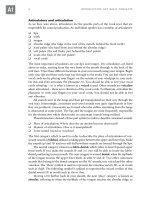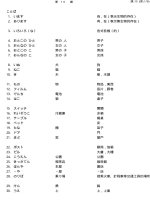SAT practise test 20000 part 4 ppsx
Bạn đang xem bản rút gọn của tài liệu. Xem và tải ngay bản đầy đủ của tài liệu tại đây (101.35 KB, 8 trang )
3. There was criticism that the councilman
was __________ when he seized the
ceremony __________ by the girl’s tragic
death to speak out against his opponent.
(A) militaristic negated
(B) opportunistic afforded
(C) unreceptive preempted
(D) passive. . created
(E) defeatist overshadowed
4. The computer expert underscored that the
new software would _____ the prior
version; users could simply __________
the old one.
(A) preclude destroy
(B) outdo implement
(C) infect disregard
(D) undermine. .detach
(E) supercede discard
5. Romania has a long and __________
tradition of activist-poets, who through
poetry have __________ the dignity and
equality of humanity.
(A) reputable initiated
(B) storied articulated
(C) tenuous supported
(D) tactile. .decried
(E) exemplary countered
6. Dr. Patel expected the surgery to be
__________ and laborious, but it turned
out to be speedy and __________.
(A) fragile simple
(B) compelling forthcoming
(C) intricate straightforward
(D) complicated. .locatable
(E) hard mechanical
7. Despite the longstanding __________
between the clans, both clans __________
each other in the aftermath of the disaster.
(A) feud assisted
(B) grudge maligned
(C) detente withstood
(D) skirmish. . ameliorated
(E) alliance discounted
8. The oral tradition of the Bambara people
of West Africa is rich with humor and
__________, characteristics which are
evident in the merriment of their every-
day life.
(A) irony
(B) mirth
(C) cynicism
(D) history
(E) mystery
9. Although Astropithicus has more subspe-
cies than Pthicalitius, the latter populates
the Earth with __________ numbers and
in more __________ geographic regions.
(A) greater diverse
(B) lesser secluded
(C) milder remote
(D) scanter. .familiar
(E) larger ominous
10. It is generally __________ by medical
practitioners that the last few weeks of a
pregnancy are crucial in the __________ of
the fetus.
(A) acknowledged progression
(B)
hedged health
(C) endorsed birthing
(D) accepted. .development
(E) negated vitality
25Copyright © 2005 Thomson Peterson’s, a part of The Thomson Corporaton
SAT is a registered trademark of the College Entrance Examination Board, which
was not involved in the production of and does not endorse this product.
11. Though the organization espoused
outward-focused ideals, in practice, it was
quite __________.
(A) gregarious
(B) vigilant
(C) insular
(D) hermetic
(E) idiosyncratic
12. The prosecuting attorney described the
defendant’s character as __________ and
base, but the defense attorney rejoined
that the prosecution was __________ the
testimonials about the defendant.
(A) dark misunderstanding
(B) nefarious misconstruing
(C) lackluster misinterpreting
(D) blustery. .misapplying
(E) motley misrepresenting
13. Many believe that the new drug regime
will be a __________ for helping cure
diverse ailments related to spinal dysfunc-
tions.
(A) bane
(B) panacea
(C) module
(D) fledgling
(E) pariah
14. The executive charged that the whistle-
blower’s actions were so self-centered that
they were not just __________ but even
__________.
(A) self-involved altruistic
(B) ill-tempered narcissistic
(C) egocentric solipsistic
(D) unduly. .respectable
(E) erratic destructive
15. Technology, instead of alleviating the
demands upon our time, has made the
pace of modern-day life increase to a near
__________ pace.
(A) elicit
(B) frenetic
(C) lethargic
(D) dilatory
(E) cavalier
Questions 16–27 are based on the following
passage.
The following passage tells the story of Juan
Bautista Rael, an Hispanic-American scholar. It
is adapted from a biography written by Enrique
R. Lamadrid.
Line Linguist and folklorist Juan Bautista Rael
was a highly regarded academic pioneer.
His major contribution to linguistics was
collecting and documenting the Hispano
folk stories, plays, and religious tradi-
tions of northern New Mexico and
southern Colorado.
Rael was born on August 14, 1900,
in Arroyo Hondo, New Mexico. Famous
for its spectacular setting north of Taos,
the village lies in a deep, narrow valley
between Taos mountain and the gorge of
the Rio Grande to the west. His family
prospered in sheep and cattle ranching
and owned a mercantile business that
served surrounding Hispano communities
as well as nearby Taos Pueblo.
Juan’s parents, José Ignacio Rael and
Soledad Santistevan, raised a family of
four sons and a daughter. José Ignacio
had the foresight to recognize the
changes that were coming with the
increasing Americanization of New
Mexico and realized that a fluent
knowledge of English and a good
education would be necessary for his
(5)
(10)
(15)
(20)
(25)
26 Copyright © 2005 Thomson Peterson’s, a part of The Thomson Corporaton
SAT is a registered trademark of the College Entrance Examination Board, which
was not involved in the production of and does not endorse this product.
family to excel. Since local schools were
rudimentary at best, the family relied
upon its own resources to get the best
possible education for the children. Juan
was a dedicated student from his earliest
years, and his father’s ambition was for
him to become a lawyer and tend to the
family lands and business. Juan’s
elementary schooling was at Saint
Michael’s College in Santa Fe, and his
high school studies were at the Christian
Brothers’ College in St. Louis, Missouri.
The boy’s semester-long absences from
his family led him to treasure the simple
pleasures of village life. Summers are
especially beautiful in Arroyo Hondo,
and Christmas and Easter vacations were
filled with colorful festivities and solemn
ceremony. Rael later reminisced about
how much the Pastores, or Shepherds’
plays, impressed him as a child. Un-
doubtedly, the instincts and sympathies
of Rael the folklorist can be traced to
these beginnings—watching rehearsals
and performances depicting shepherds,
hermits, and the rich ensemble of
pastoral characters.
What became clear in his post-
secondary studies is that he was much
more attracted to literature, philology,
and the emerging disciplines of linguistics
and folklore. His Bachelor’s degree, from
St. Mary’s College in Oakland in 1923,
led to a Master’s degree from the
University of California at Berkeley in
1927. In the meantime, in 1923, he
married Quirina Espinoza of Antonito,
Colorado. Rael’s first inclination was to
become an English teacher, but his bride
helped convince him that his opportuni-
ties and strengths would be as an
Hispanist. After deciding on a university
career of teaching and research, Rael
relinquished his family inheritance in
land, cattle, and sheep to his three
brothers and his sister.
Rael realized that the wealth in
northern New Mexico that interested
him was the vast repertory of folk
narrative, song, and custom that had
scarcely been documented. While
teaching at the University of Oregon, he
returned to Arroyo Hondo in the summer
of 1930 to begin compiling his famous
collection of over five hundred Nuevo
Mexicano folk tales.
By then his work had attracted the
attention of pioneer Hispano folklorist
Aurelio Espinosa who invited Rael to
Stanford in 1933. Rael completed his
doctoral studies in 1937 there with a
dissertation on the phonology and
morphology of New Mexico Spanish that
amplified the work of Espinosa with the
huge corpus of folk tales, later published
as, Cuentos Españoles de Colorado y
Nuevo Mexico: Spanish Folk Tales of
Colorado and New Mexico.
Well versed in the historic-geographic
theory of transmission and diffusion of
motifs, tale types, and genres, Dr. Rael
set out on the formidable, almost
quixotic task of gathering all the possible
versions and texts of the tales, hymns,
and plays he was studying. The vast
majority of tales are of European
provenance, with only minimal local
references. He meticulously traced the
shepherds’ plays to several root sources
in Mexico, and his study, The Sources
and Diffusion of the Mexican Shepherds’
Plays, is a standard reference on the
subject. His ground-breaking study of the
alabado hymn, The New Mexican
Alabado, is also a prime resource. But
inevitably the historic-geographic
(30)
(35)
(40)
(45)
(50)
(55)
(60)
(65)
(70)
(75)
(80)
(85)
(90)
(95)
(100)
(105)
(110)
27Copyright © 2005 Thomson Peterson’s, a part of The Thomson Corporaton
SAT is a registered trademark of the College Entrance Examination Board, which
was not involved in the production of and does not endorse this product.
approach led more to collection building
than to analysis. Later generations of
scholars would develop interests in
performance-centered studies, but the
collections of Rael continue to be an
indispensable landmark in the field.
16. The author’s attitude towards Dr. Rael’s
work can best be described as
(A) laudatory.
(B) engaged.
(C) ambivalent.
(D) disinterested.
(E) condescending.
17. The passage primarily
(A) analyzes the academic contributions
of Dr. Rael.
(B) contrasts Dr. Rael’s work with the
work of Dr. Espinosa.
(C) tells the story of Dr. Rael’s life and
work.
(D) discusses the basic assumptions of
Hispano scholarship.
(E) relates the story of the Rael family.
18. The passage implies that Rael decided that
he would have more opportunity as a
Hispanist than as an English teacher
because
(A) Hispanics weren’t often hired to
teach English.
(B) Hispanic folklore would soon vanish.
(C) he would have to live far from his
family to teach English.
(D) his English skills were mediocre.
(E) becoming an Hispanist was a nearer
match to his educational back-
ground.
19. The author probably uses the word
“relinquished” in line 70 to emphasize
that
(A) Rael had had friction with his
siblings.
(B) Rael’s family was very wealthy.
(C) Rael had tried to be a rancher for
some time.
(D) Rael was relieved to be free of his
family duties.
(E) Rael’s career path was difficult and
not lucrative.
20. It can be inferred from the passage that
northern New Mexico in the early decades
of the twentieth century
(A) had a ranch-driven economy.
(B) was suffering severe economic
depression.
(C) was economically booming because
of a newly opened southern railroad
route to California.
(D) had a strong public education system.
(E) was not a primarily English-speaking
region.
21. Which of the following best describes Dr.
Espinosa’s relationship to Dr. Rael?
(A) Boss
(B) Critic
(C) Mentor
(D) Pastor
(E) Father
22. The word “corpus” in line 91 most closely
means
(A) religious text.
(B) oeuvre.
(C)
published collection.
(D) dissertation.
(E) dialect.
(115)
28 Copyright © 2005 Thomson Peterson’s, a part of The Thomson Corporaton
SAT is a registered trademark of the College Entrance Examination Board, which
was not involved in the production of and does not endorse this product.
23. According to the passage, which of the
following of Dr. Rael’s activities as a
young man was most important for the
development of his later academic
interests?
(A) Working on his family’s ranch
(B) Watching Pastores as a young man
(C) Studying in a religious school
(D) Reading books on the shepherds of
northern New Mexico
(E) Struggling to retain his Spanish when
his schooling was in English
24. The phrase “diffusion of motifs” in lines
96–97 refers to
(A) variations in the same stories that
occur over time or by region.
(B) adherence to standard literary
structures.
(C) variations in language use by region.
(D) the surprising similarity of stories in
different cultures.
(E) the loss of folklore in more industri-
alized societies.
25. The word “provenance,” line 103, could
best be replaced with which of the
following words?
(A) Authority
(B) Origin
(C) Location
(D) Destiny
(E) Ethos
26. The main criticism the author offers of Dr.
Rael’s work is that it
(A) focuses too much on the Pastores.
(B) privileges Spanish-language stories
over English-language stories.
(C) focuses too much on European
stories and not enough on Mexican
stories.
(D) doesn’t offer enough analysis of the
folklore.
(E) includes too many materials, without
differentiating between good and
bad.
27. The passage suggests, in lines 97–101 that
Dr. Rael
(A) was mistaken about how much
folklore was circulating.
(B) traveled extensively as he gathered
folklore.
(C) was disorganized but intelligent in
his methods.
(D) had an historic insight about the
source of New Mexican folklore.
(E) developed an excessively technical
model for the development of
folklore.
STOP
Do not proceed to the next section until time is up.
29Copyright © 2005 Thomson Peterson’s, a part of The Thomson Corporaton
SAT is a registered trademark of the College Entrance Examination Board, which
was not involved in the production of and does not endorse this product.
Section 5
21 Questions j Time—25 Minutes
Directions: Solve the following problems using any available space on the page for scratchwork.
Mark the letter of your choice on the answer sheet that best corresponds to the correct answer.
Notes:
1. You may use a calculator. All of the numbers used are real numbers.
2. You may use the figures that accompany the problems to help you find the solution. Unless
the instructions say that a figure is not drawn to scale, assume that it has been drawn
accurately. Each figure lies in a plane unless the instructions say otherwise.
Reference Information
w
b
h
h
w
h
b
a
c
3x
r
r
2x
30
60
45
45
2s
s
s
x
A 5pr
2
C 5 2prA5 ,w
A 5
1
2
bh
V 5 ,wh V 5pr
2
hc
2
5 a
2
1 b
2
Special Right Triangles
The number of degrees of arc in a circle is 360.
The measure in degrees of a straight angle is 180.
The sum of the measures in degrees of the angles of a triangle is 180.
1. At full capacity, Thompson Paper Factory
produces 200 sheets of paper per second.
If the factory is operating at a quarter of
its full capacity, how many sheets of paper
will the factory produce in twelve sec-
onds?
(A) 600
(B) 900
(C) 1200
(D) 2000
(E) 2400
2.
If Z 5
2x
5
and Z 5 3, then x 5
(A)
5
3
(B)2
(C)5
(D)
19
3
(E)
15
2
30 Copyright © 2005 Thomson Peterson’s, a part of The Thomson Corporaton
SAT is a registered trademark of the College Entrance Examination Board, which
was not involved in the production of and does not endorse this product.
3. Which of the following is the greatest
common factor of 32 and 42?
(A)2
(B)3
(C)6
(D)8
(E)12
4.
What is the slope of the above line?
A.
2
3
2
B.
2
2
3
C.
2
3
D. 1
E.
3
2
Questions 5–6 refer to the following table.
5.
According to the table, how many
students are there in 3
rd
and 4
th
grade at
Hyde Park Elementary?
(A)30
(B)32
(C)50
(D)60
(E)62
6. If there are 18 girls in 4
th
grade, how
many boys are there in 3
rd
and 4
th
grade
at Hyde Park Elementary?
(A)18
(B)22
(C)26
(D)30
(E)32
31Copyright © 2005 Thomson Peterson’s, a part of The Thomson Corporaton
SAT is a registered trademark of the College Entrance Examination Board, which
was not involved in the production of and does not endorse this product.
7. Which of the following is the value of the
exponent when the expression
~
m
3
4
!
22
m
5
4
is
simplified?
(A)
2
11
4
(B)
2
29
16
(C)
2
3
4
(D)
11
4
(E)
29
6
8.
In the right triangle above, what is the
value of x?
(A)15
(B)16
(C)18
(D)24
(E)30
9. Taking the highway from Easton to
Bethsaida is 7 miles longer than taking
surface streets from Easton to Bethsaida.
It is 31 miles total if you travel from
Easton to Bethsaida via highway and
return via surface streets. How many miles
then, is the highway route?
(A)12
(B)13
(C)15
(D)17
(E)19
10.
If f
~
x
!
5
3x
2
x
2
1 3x 2 18
, for what values
of x is the function undefined?
(A)0
(B) 23,6
(C) 23,3
(D) 2,5
(E)3,26
11.
If f(x) is graphed above, then f(x) 5
(A) x
2
1 2
(B) x
2
2 2
(C) 2x
2
1 2
(D) 2(x
2
1 2)
(E) 2(x 12)
2
12.
If the above triangles are congruent, what
is the value of y?
(A)5
(B)
=
50
(C)8
(D)
=
75
(E)9
32 Copyright © 2005 Thomson Peterson’s, a part of The Thomson Corporaton
SAT is a registered trademark of the College Entrance Examination Board, which
was not involved in the production of and does not endorse this product.









